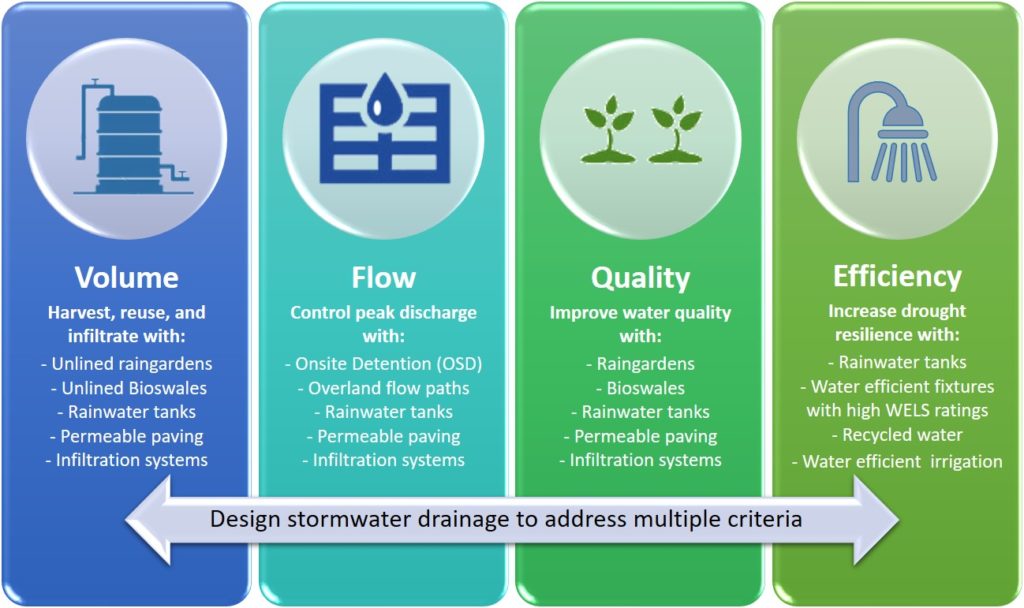Much has changed in Victorian Stormwater policy and law and many stormwater professionals have been working hard to understand the changes. Key changes are to Victorian Planning Policies and to the EPA laws the State Environmental Protection Policies (SEPPs)
Planning Policy Amendment VC154
New integrated water management planning policies were gazetted in October 2018.
The key elements include:
- A new definition of stormwater 73.01 General terms
- Stormwater: The net increase in run-off from urban development due to water not being able to seep into the ground because of impervious surfaces, such as roofs and roads.
- New Integrated water management clause in the state’s Planning Policy framework (PPF) to embed IWM objectives and strategies into urban land-use planning.
- New provisions, under the Victoria Planning Provisions (VPP), to expand the current stormwater management requirements to:
- commercial subdivisions and developments
- industrial subdivisions and developments
- public use developments
- residential multi-dwelling subdivisions and developments including townhouses
- In particular Standard B9 55.03-4 Permeability and stormwater management objectives (26/10/18 VC154) requires assessment of smaller developments such as townhouses:
- The site area covered by the pervious surfaces should be at least:
- The minimum area specified in a schedule to the zone, or
- If no minimum is specified in a schedule to the zone, 20 percent of the site.
- The stormwater management system should be designed to:
- Meet the current best practice performance objectives for stormwater quality as contained in the Urban Stormwater – Best Practice Environmental Management Guidelines (Victorian Stormwater Committee, 1999).
- Contribute to cooling, improving local habitat and providing attractive and enjoyable spaces.
- The site area covered by the pervious surfaces should be at least:
Details of changes can be found at https://www.water.vic.gov.au/liveable/stormwater
New Environmental Protection Act – SEPP (Waters)
The SEPP (Waters) formally commenced on 19 October 2018. This is the largest change in stormwater regulation related to Councils in over a decade.
The SEPPs outline the uses and values of the environment that the community want to protect (these are called beneficial uses) and define the quality of the environment required to protect these. SEPPs also identify the rules for decision makers and obligations on industry in order to protect water environments.
Section 34 – Management of Urban Stormwater of the new SEPP (Waters) nominates Councils as the authority responsible for ensuring that all new developments meet the environmental objectives of the Best Practice Environmental Management Guidelines (BPEM) for Urban Stormwater to implement source control measures to:
- Minimise the quantity of stormwater leaving the property boundary;
- Hold or use it as close to where it is generated as possible; and
- Minimise the pollution of stormwater.
The SEPP (Waters) also requires that owners and managers of assets created to protect water quality (including constructed sediment ponds and wetlands) must ensure those assets are designed well and maintained properly.
Section 34 of the SEPP (waters) can be found here
How InSite Water allows designers to demonstrate compliance
For redevelopment sites under 1 hectare, InSite water allows designers to quickly and effectively demonstrate requirements of the Integrated Water Management Planning Policies and the SEPP (Waters). InSite allows this because it takes a multi criteria approach, where one stormwater device – such as a water tank or WSUD device such as a raingarden or infiltration pit can demonstrate how it meets both hydrology and environmental requirements. In addition we allow users to calculate Volume reduction to minimise the quantity of stormwater leaving the property boundary.
InSite water includes clear targets in line with Integrated Water Management requirements, and measures performance of a design to show whether those targets have been met.

